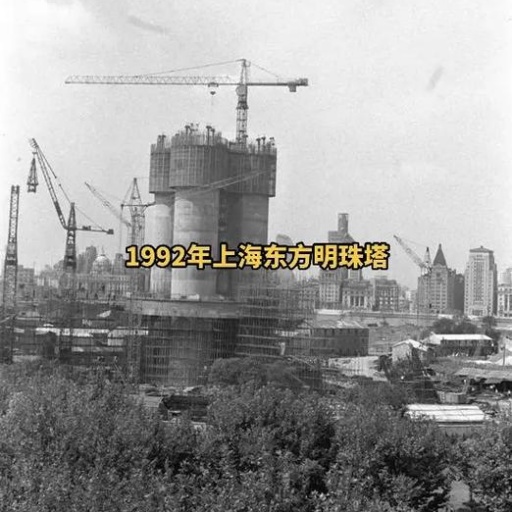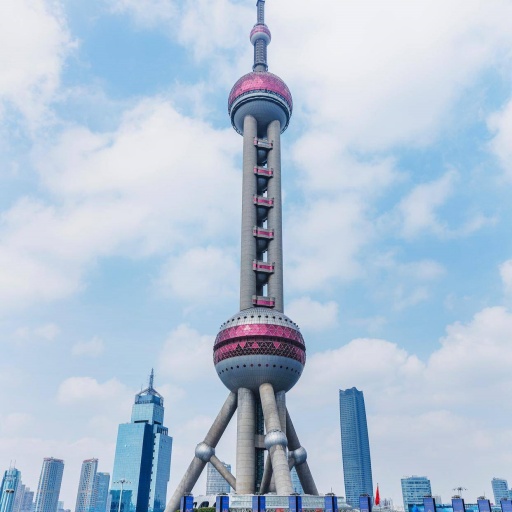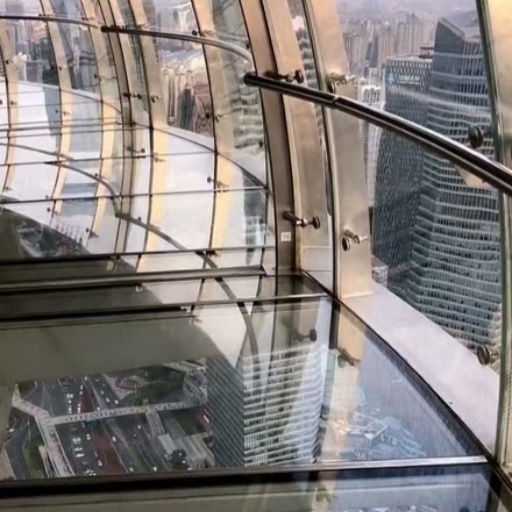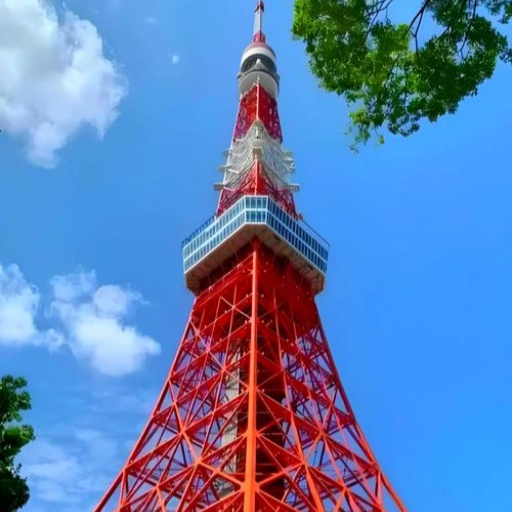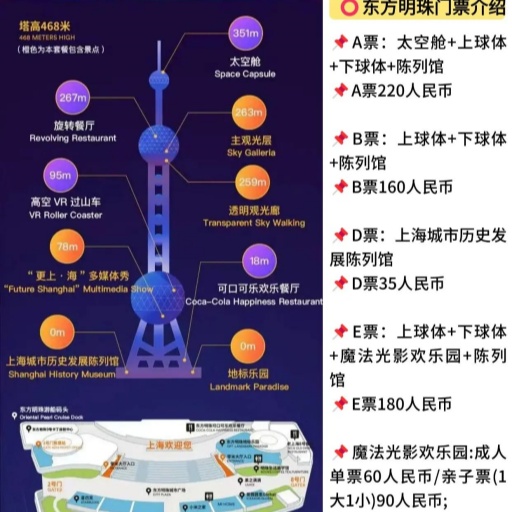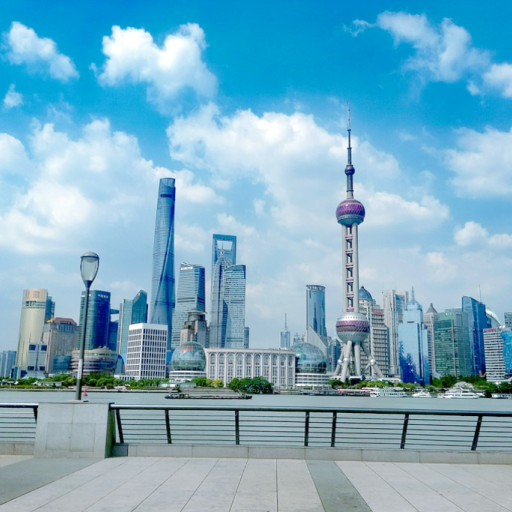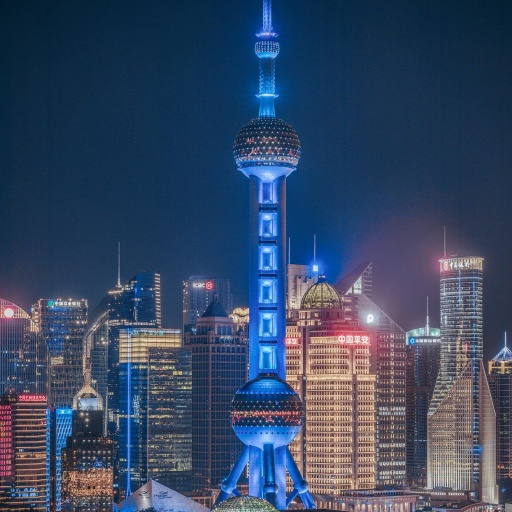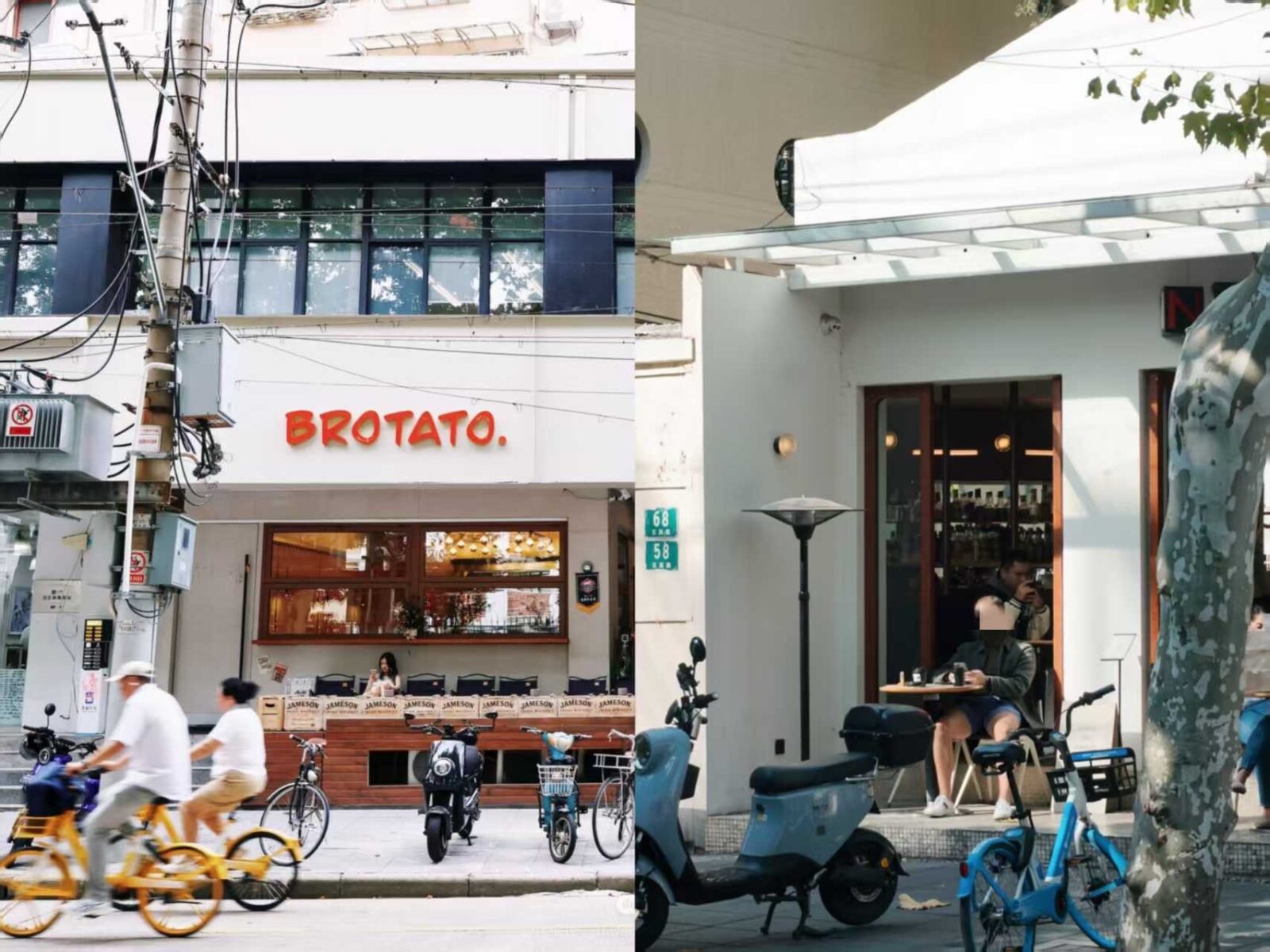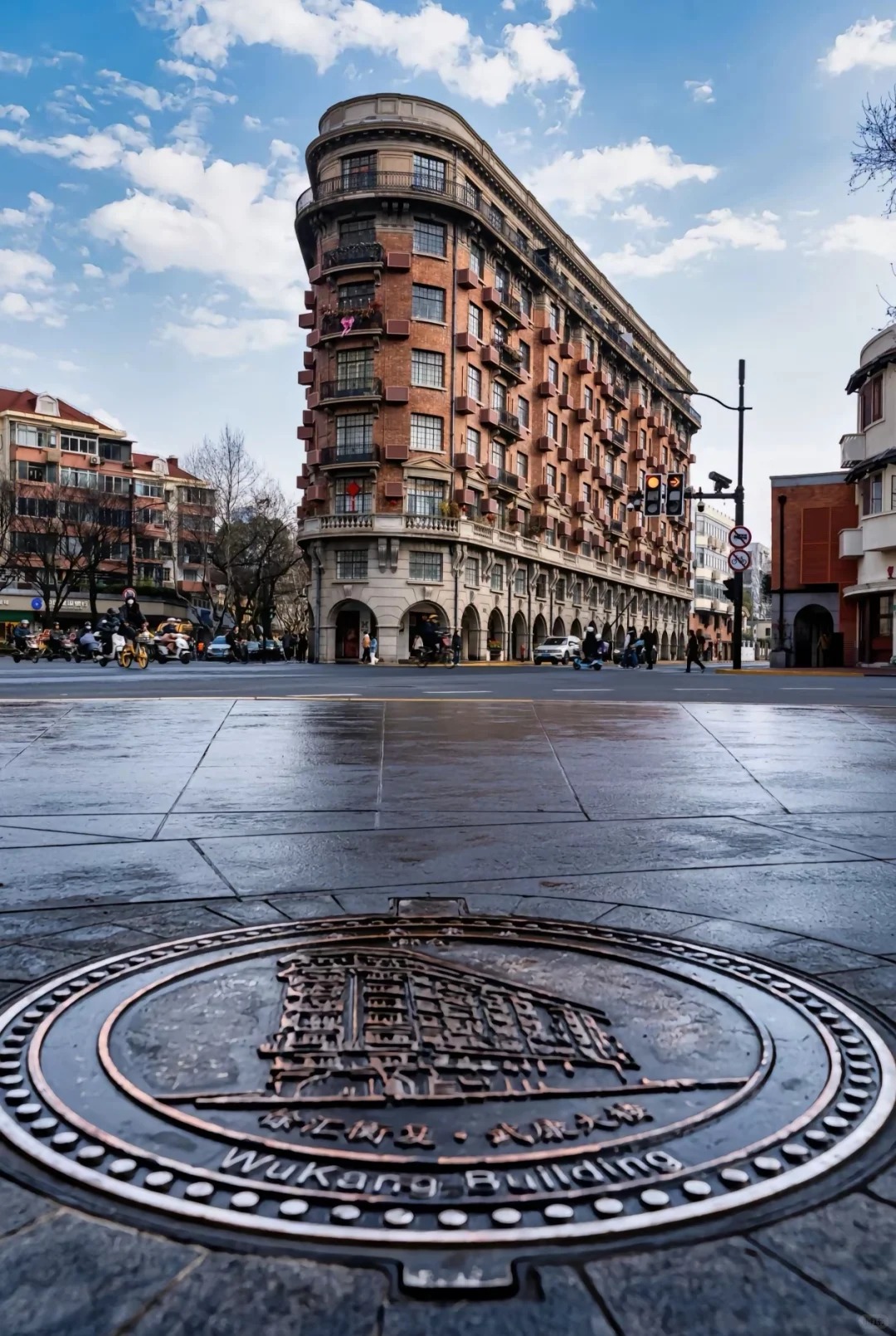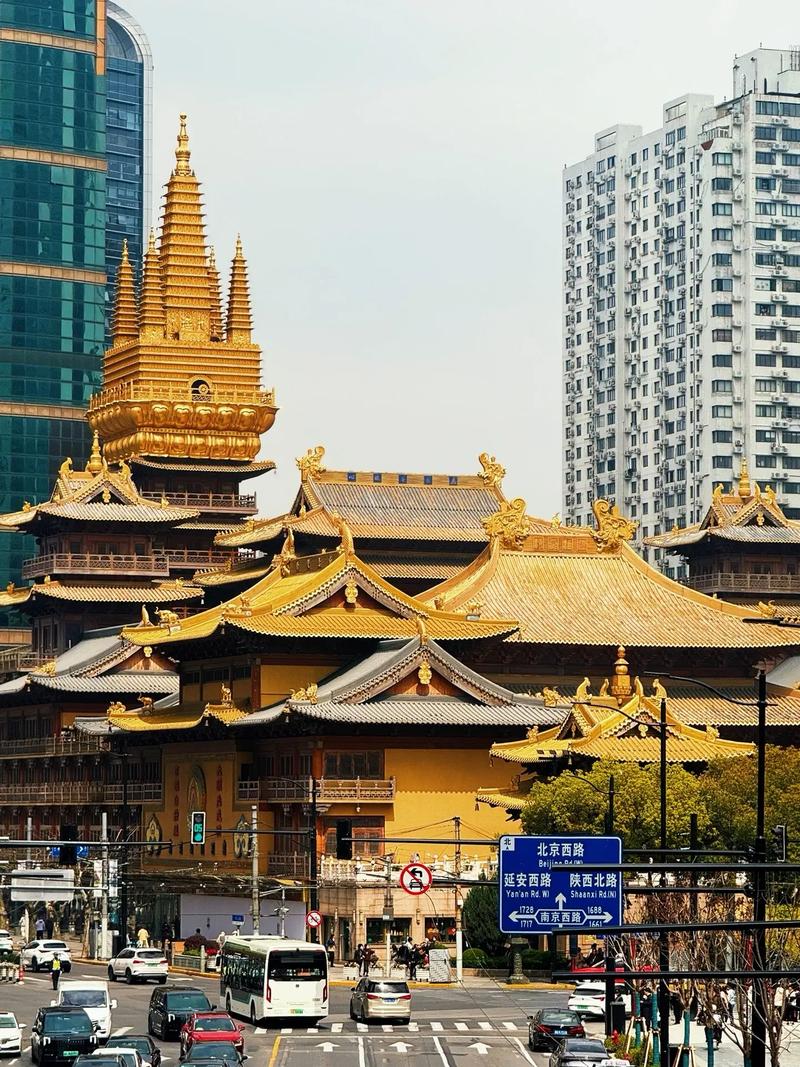If you’ve ever seen a photo of Shanghai, chances are the Oriental Pearl TV Tower was right there, stealing the spotlight with those giant pink orbs. This isn’t just some random skyscraper — it’s the symbol of modern Shanghai, part sci-fi movie set, part time capsule, and 100% unmissable. Whether you're here for skyline views, retro vibes at the basement museum, or just want to say you had dinner spinning 263 meters above ground, this tower’s got you covered. Let’s break down what makes the Oriental Pearl TV Tower so legendary — and how to totally win your visit.
Of course, if you want to know what other iconic attractions there are in Shanghai, this article should help you.
What is the Oriental Pearl TV Tower and why is it so iconic?
- The oriental Tower under construction in 1992.
- The Oriental Pearl Tower finished in 1994.
- The Oriental Pearl Tower in 2025.
The origin and meaning behind its design
The Oriental Pearl TV Tower’s design wasn’t born out of thin air. It was inspired by a line from a Tang Dynasty poem: “big and small pearls falling on a jade plate.” That image led to the tower’s iconic “string-of-pearls” design. Eleven spheres of different sizes are stacked along the vertical axis. The larger spheres contain observation decks and event spaces. The smaller ones tie the structure together, making it flow. You don’t just see a tower—you see poetry turned into steel and glass. It’s architectural storytelling at its finest.
What makes it more special is how it blends old and new. The ancient poetic idea is paired with cutting-edge engineering. The whole thing stands on three giant columns, giving the illusion it’s floating. From the base to the antenna tip, each part serves a cultural or practical purpose. In Chinese culture, round shapes symbolize unity. That’s why the spheres don’t just look pretty—they carry meaning. Locals often say it looks like lanterns or a traditional bead necklace. Tourists snap photos non-stop, especially at night when the whole tower glows.
The tower’s pink-purple glow isn't random either. Pink stands for imagination and love in Chinese tradition. Purple adds mystery and depth. Together, they light up the skyline with personality. The tower doesn’t shout for attention—it earns it. Whether you’re arriving by river ferry or taxi, it catches your eye instantly. It's not just a TV tower. It’s a piece of Shanghai’s soul, shaped like a dream and grounded in history.
Key historical moments since its opening
The Oriental Pearl TV Tower officially opened in 1994, and Shanghai hasn’t looked the same since. Back then, Pudong was still rising. The tower was the first to truly stand out on the east side of the Huangpu River. It was the tallest structure in China at the time. People lined up just to ride the elevator. News crews called it the "needle of the future." For many locals, its opening felt like Shanghai stepping into a new era.
As years passed, the tower became a symbol of growth. It hosted major national events, light shows, and even global TV broadcasts. During the 2010 Shanghai World Expo, it served as a glowing landmark for visitors from around the world. The tower’s image appeared on coins, stamps, and travel ads. It was everywhere. For older generations, it became part of daily life—something they pointed to when telling stories. For kids, it was the place they visited on school trips, wide-eyed and thrilled.
Even now, the tower keeps evolving. It’s had multiple renovations to upgrade lighting, exhibits, and safety. In recent years, interactive tech and digital art have been added. The basement now holds the immersive Shanghai History Museum. From the outside, the tower still looks the same. But inside, it grows with the times. Locals call it “old friend in new clothes.” The Oriental Pearl TV Tower isn’t just part of Shanghai’s past—it adapts, shines, and stays relevant.
Oriental Pearl TV Tower in the context of modern Shanghai
In today’s Shanghai, the Oriental Pearl TV Tower is more than just a tall building. It’s a cultural icon. You see it in movies, commercials, and even video games. It’s the anchor of the Lujiazui skyline. Tourists look for it as soon as they arrive. Locals say, “If you can see the tower, you’re home.” It represents the city’s confidence—bold, elegant, and always looking ahead.
But the tower also stands for balance. Shanghai moves fast, yet the Oriental Pearl reminds people of roots. Its poetic shape ties it to heritage. Its high-tech interior keeps it future-facing. That mix mirrors the city itself. Where else can you find old lilong alleyways near glass skyscrapers? The tower bridges tradition and innovation. It proves that cities can honor the past while racing toward tomorrow.
And yes—it’s a global icon too. It’s been ranked among the world’s top city towers. It’s also a favorite shooting location for drone videos and fashion campaigns. Whenever Shanghai wants to show off its skyline, this tower takes center stage. It’s not just a building—it’s a mood, a statement. The Oriental Pearl TV Tower gives Shanghai a recognizable face. And that face smiles with style, strength, and deep cultural pride.
What can you actually experience inside the Oriental Pearl Tower?
- The structure of the Oriental Pearl Tower
- Glass Skywalk
- Revolving restaurant
Observation decks – from glass floors to 360° skyline views
The observation decks at the Oriental Pearl Tower are truly something else. The main deck sits at 263 meters high. From here, you get a full 360-degree view of Shanghai’s skyline. The glass windows let you see landmarks like the Shanghai Tower and the Huangpu River stretch out below.
One standout feature is the transparent glass floor at 259 meters. Walking on it feels thrilling and a bit nerve-wracking. You can literally see the ground far below. It’s a favorite spot for visitors looking for a little adrenaline with their sightseeing.
Besides views, the decks have binoculars and info boards to help you spot and learn about the buildings around. The whole setup makes it easy to soak in the cityscape. Also, the lighting changes at night, giving the skyline a totally different vibe, perfect if you visit at sunset or after dark.
Shanghai History Museum in the basement
Beneath the tower lies the Shanghai History Museum. It’s a cool spot showcasing Shanghai’s past. You’ll find life-size recreations of old Shanghai streets, shops, and neighborhoods. It feels like stepping back in time.
The museum uses multimedia and interactive displays to bring history alive. You can learn about Shanghai’s growth from a fishing village to a global metropolis. There’s also information about traditional festivals, including the dragon boat festival food culture, showing how zongzi and other treats became part of local customs.For families, it’s a nice break from the heights and offers a chance to dive into local culture. The museum opens at 9 AM and closes at 9 PM, so you can easily fit it into your visit to the tower.
Dining in the revolving restaurant
Eating in the tower’s revolving restaurant is a special treat. Located at 263 meters, it spins slowly, giving diners a constantly changing view. You don’t have to move to see different angles — the cityscape moves around you.
The restaurant serves a mix of Shanghai and international dishes. The food tastes good, but the view steals the show. It’s especially nice for dinner when the city lights sparkle below.Booking a table in advance is recommended, especially during weekends or festivals like the dragon boat festival. The restaurant fills up fast because many visitors want to combine great food with stunning views.
How tall is the Oriental Pearl TV Tower compared to other famous towers?
- The Oriental Pearl Tower.
- Tokyo Tower
Exact height and structure breakdown
The Oriental Pearl TV Tower stands at 468 meters. That’s no small feat. This height includes the antenna spire, the main body, and all observation spheres. It was once the tallest structure in China before being surpassed by newer skyscrapers like Shanghai Tower. Still, its design makes it look even taller than it is—thanks to those shiny spheres stacked like beads on a stick.
The tower has 11 spheres of varying sizes. Three big ones catch most of the attention. The bottom large sphere sits at 90 meters and houses a museum and shops. The middle sphere is the most popular—it’s at 263 meters and offers sweeping views of Shanghai. That’s where people snap skyline photos or dare to step on the glass floor. The top space capsule, sitting at 351 meters, is enclosed in a smaller sphere and gives an even higher vantage point.
Between these spheres are elevators, platforms, and walkways. The structure is held up by three slanted columns that meet underground, giving it that futuristic floating look. It’s not just tall—it’s structurally complex. Walking through the tower feels like moving up a vertical science museum. No matter which floor you're on, there's always something to learn or look at. The design cleverly mixes form and function without ever feeling boring.
Comparison with Tokyo Tower and other global towers
Let’s compare heights. Tokyo Tower stands at 333 meters. That means the Oriental Pearl beats it by 135 meters. Tokyo Skytree, however, towers over both at 634 meters—it’s Japan’s tallest. Guangzhou’s Canton Tower comes in at 600 meters. So where does that put the Oriental Pearl? Not at the very top, but still firmly in the elite league of global towers.
Unlike some towers that focus purely on broadcasting or tourism, the Oriental Pearl mixes everything. It’s shorter than Burj Khalifa, sure—but it has more “personality.” Some say it’s not just about height, but what you do with it. And the Pearl does a lot. From hosting events to projecting laser shows, it’s way more than an antenna.
In Asia, only a few towers beat it in height. But few match its cultural presence. Tourists often visit multiple towers in one trip—say, Shanghai Tower for height, Jin Mao for elegance, and Oriental Pearl for character. It adds flavor to the skyline, much like dragon boat festival food brings richness to the holiday table. It may not be the tallest anymore, but it’s often the most photographed.
Why its height still matters today?
Even with taller towers nearby, the Oriental Pearl’s height still packs a punch. You feel it the moment you approach from the Bund. It dominates the skyline like a guardian watching over the city. It draws your eye upward, especially when it's lit at night. Height still impresses, no matter how many buildings pop up around it.
The tower’s strategic height was carefully chosen. It allows for optimal signal transmission and gives visitors a clear view above the city's denser districts. Climbing the tower—whether by elevator or escalator—feels like ascending through Shanghai’s story. Each level shows a different face of the city: historical below, financial at mid-level, futuristic at the top.
Also, height equals recognition. Just like zongzi is instantly recognized as dragon boat festival food, the Oriental Pearl is instantly identified by its silhouette. Kids draw it in school. Tourists seek it out. Locals glance at it for weather clues. And that’s the power of elevation—not just in meters, but in meaning. It doesn’t just rise above the ground; it rises above trends.
How do you visit the Oriental Pearl TV Tower as a tourist?
- Oriental Pearl TV Tower Ticket Price List
- The night view from the observation deck of the Oriental Pearl Tower
Getting there: metro, taxis, and walking routes
Getting to the Oriental Pearl Tower is pretty straightforward. Most people take the metro. The closest station is Lujiazui on Line 2. From there, the tower is just a short walk, only about five minutes. Just follow the crowds, and you’ll find it easily. The signage is clear, and lots of locals and tourists use the same route.
If you prefer taxis, they are everywhere in Shanghai. Tell the driver “Dongfang Mingzhu”or show the address in Chinese. Taxi rides from the city center usually take 15-20 minutes, depending on traffic. It’s a convenient option, especially if you want to avoid walking or metro transfers.
For those who want to soak in the surroundings, walking along the Huangpu River promenade is great. The tower looks stunning from the Bund area. You can stroll from the Bund to Lujiazui, which takes around 20-30 minutes. Along the way, you’ll spot other landmarks like the Shanghai Tower and Jin Mao Tower. This route is especially lovely at sunset, perfect for snapping photos of the skyline and nearby dragon boat festival food stalls that pop up around the area during the festival season.
Ticket types, prices, and where to book
There are two main ticket packages for the Oriental Pearl Tower. Package One costs 199 RMB. It includes access to the 263-meter main observation deck, the 259-meter transparent skywalk, the 78-meter "Future Shanghai" multimedia show, the 90-meter sightseeing corridor, and the Shanghai History Museum. Kids under 1 meter tall enter free.
Package Two ranges from 255 to 318 RMB. It offers everything in Package One plus a 45-minute Huangpu River cruise. This is perfect if you want a fuller Shanghai experience. Again, children under 1 meter ride free.If you prefer just the Shanghai History Museum, tickets cost 35 RMB. Both the museum and the tower open from 9:00 AM to 9:00 PM, with last entry at 8:30 PM.
It’s best to buy tickets online in advance, especially during peak seasons or holidays. Online booking saves time by skipping long lines. You can purchase through official sites or trusted travel platforms. During festivals like the dragon boat festival, many visitors come to enjoy the views and also try local festival foods like zongzi nearby, so booking ahead is wise.
Best times to visit for fewer crowds and better views
If you want fewer people around, weekdays are your best bet. Early mornings right at opening time give you a quieter experience. Also, visiting during the shoulder seasons — late spring or early autumn — means better weather and fewer tourists.
Sunrise and sunset are magical times to visit. The tower glows as the city lights turn on, and you get fantastic photos of the skyline blending with the river reflections. Cloudy or hazy days are less ideal, so checking the weather before you go is wise.
If you can, avoid Chinese national holidays and weekends. These are peak times with large crowds. The dragon boat festival itself can bring extra visitors, but it’s also when the city feels lively with cultural buzz and festive food stalls. That adds a special flavor to your visit, even if it means a bit more company.
How should you explore the Oriental Pearl TV Tower for the best experience?
- Oriental Pearl Tower from the Bund
- Oriental Pearl Tower by Day
- Oriental Pearl Tower at Night
Recommended visiting times and duration
To make the most of your visit, plan for about 1.5 to 2 hours inside the tower. This gives enough time to see everything without rushing. Arriving right at opening time helps you avoid big crowds.
If you visit during off-peak hours, the lines are shorter. Avoid weekends and public holidays for a more relaxed visit. Also, early mornings or late afternoons provide softer lighting for photos and a calmer atmosphere.During special occasions like the dragon boat festival, crowds can increase. Yet, the festive vibe is worth it, especially with street vendors selling zongzi nearby. Just be prepared for some wait times.
Suggested route inside the tower
Start your visit at the Shanghai History Museum in the basement. It gives you a solid background on the city before heading up. Afterward, head to the main observation deck at 263 meters for breathtaking views.
Next, check out the 259-meter transparent skywalk for a thrill. Then move to the 90-meter sightseeing corridor for different angles of the skyline. Finish with a meal or drink at the revolving restaurant.
Don’t miss the souvenir shop on your way out. It offers unique gifts themed around Shanghai and the tower. This route flows well and makes sure you catch all highlights.
Where to take the best photos of the tower
The Oriental Pearl Tower looks amazing from several spots. The Bund offers classic views with the river and historic buildings in the frame. At night, the tower lights up beautifully against the dark sky.
Lujiazui Central Green Space is another favorite photo spot. It gives you a full shot of the tower with modern skyscrapers nearby. The Huangpu Riverside Promenade offers a wide, open view perfect for wide-angle shots.Try different angles and times of day. Sunrise, sunset, and night bring unique lighting. Many photographers swear by the Bund for capturing the iconic Shanghai skyline with the tower.
Reference
Frequently Asked Questions (FAQs)
Q: What time does the Oriental Pearl Tower light up?
A: The Oriental Pearl Tower usually lights up around sunset, between 6:30 and 7:00 pm, depending on the season. The lights gradually brighten as daylight fades. They stay on until around 10:00 pm, sometimes later on weekends or holidays. Locals say the view from the Bund during that hour is simply breathtaking. You’ll see the tower glow in vibrant colors, and the reflections on the Huangpu River add a magical vibe. You don’t need a ticket to enjoy this nighttime view. In fact, many visitors skip the tower’s interior and opt for an outdoor view instead. If you're into skyline photography, come early to grab a good spot. You might also catch street musicians or food vendors nearby, which adds to the mood. For the best visual impact, wait until the sky turns deep blue. That’s when the contrast really makes the tower pop in photos. Keep in mind that on foggy or rainy days, the lights still turn on, but visibility may drop. So, check the weather before heading out.
Q: What are the opening hours of the Shanghai History Museum inside the Oriental Pearl Tower?
A: The Shanghai History Museum inside the tower opens daily from 9:00 am to 9:00 pm. Last admission is around 8:30 pm. It's located at the base of the tower, so you don't need to go up to visit. This museum is actually a hidden gem. Locals bring their kids here to learn about Old Shanghai. You’ll find life-sized dioramas, model trams, old shop signs, and even vintage lanterns. It paints a vivid picture of how Shanghai evolved. Unlike most modern museums, this one’s got charm and real storytelling. If you're tight on time, you can still squeeze in a visit, as the whole museum takes about 40–60 minutes to explore. It’s also great for rainy days or when you want to stay indoors. Tickets cost 35 RMB, and kids under 1 meter get in free. You can buy tickets at the entrance or as part of a combo pass with the tower. Go early in the day or after 7:00 pm to avoid school groups and crowds.
Q: Where is the best place to take photos of the Oriental Pearl Tower and other skyscrapers?
A: The best photo spots are across the Huangpu River, especially from the Bund. You’ll get the full skyline with the Oriental Pearl Tower, Shanghai Tower, and Jin Mao all lined up. It’s postcard material. Arrive around 5:30 pm to catch golden hour and stay until lights come on. The riverside promenade gives you plenty of space to shoot from different angles. Some folks even bring tripods, but handheld shots work fine if the light’s good. Another underrated spot is the rooftop bar at Hyatt on the Bund. You’ll need to buy a drink, but the views are worth it. Also check out Lujiazui Central Green space. It’s right behind the tower and gives you close-up angles with fewer people. Locals also recommend the ferry crossing for moving shots on water. If you're into creative photos, use reflections in puddles or glass surfaces nearby. And don’t forget to look up—framing the tower with trees or nearby buildings adds style.
Q: If we don’t go inside the Oriental Pearl Tower, where can we get the best photos of the tower and surrounding skyscrapers?
A: You don't need to go inside the tower to get epic photos. In fact, the most popular shots come from outside. Head straight to the Bund. That’s where you’ll find tourists and locals with cameras every evening. You’ll see the whole skyline, with the Pearl Tower front and center. Another great angle is from Pudong Riverside Promenade. This spot gives a more dramatic close-up. Plus, fewer people know about it. You can also walk over to Century Park’s edge near the river. It’s quiet, and the framing is clean. If you’re up for it, take a ferry ride during sunset. The 45-minute cruise offers moving views that look amazing in photos. Try shooting from under the Nanpu Bridge too—it’s a hidden corner locals love. Street photographers often catch great compositions there. Bring your phone or camera with night mode if you're staying after dark. The lights turn the skyline into a neon wonderland.
Q: What rank is the Oriental Pearl Tower among global towers?
A: The Oriental Pearl Tower used to be one of the tallest in the world. When it opened in 1994, it ranked third globally. Now, it's dropped a few spots. As of today, it stands at around number six among TV towers worldwide. It’s 468 meters tall. That’s taller than Tokyo Tower but shorter than Canton Tower and Tokyo Skytree. Despite dropping in rank, locals still see it as Shanghai’s most iconic structure. It’s not just about height—it’s about presence. The tower’s unique "string of pearls" design sets it apart. It’s featured in countless films, postcards, and drone shots. Tourists often think it’s taller than it actually is. Maybe because it looks massive when you stand below it. Though other towers beat it in size, few match its cultural status. In short, it's no longer at the top, but it still dominates the skyline in people’s hearts.
Q: What is the highest TV tower in China?
A: The tallest TV tower in China is the Canton Tower in Guangzhou. It reaches 600 meters. That’s much higher than the Oriental Pearl Tower’s 468 meters. The Canton Tower opened in 2010 and quickly took the crown. It even ranked second tallest in the world for a while. But height isn’t everything. Many still prefer the Pearl Tower for its classic design and location. The Canton Tower looks more futuristic, with a twisted shape. It has its own charm, for sure. However, if you're touring Shanghai, the Pearl Tower feels more connected to the city’s past and present. It’s also easier to access with public transport. The Canton Tower wins in terms of height and thrill rides, though. It has a sky drop ride near the top. So, if you’re chasing the highest point, head to Guangzhou. If you want cultural vibes with a view, stick with Shanghai.
Q: Is the Oriental Pearl Tower suitable for kids or families with children?
A: Yes, the Oriental Pearl Tower works great for families. Kids love the glass-floor observation deck. It’s 259 meters high and feels like walking on air. There's also a small theater inside showing fun 3D short films. Plus, the Shanghai History Museum has interactive displays. Little ones can see what Shanghai looked like 100 years ago. Some areas even have photo zones and touch screens for children. The tower offers plenty of rest spots, too. So parents can take a break while kids explore. The elevators are fast, and strollers are allowed. You can even grab snacks at the café near the viewing level. Just avoid peak hours, or you’ll face long lines and cranky toddlers. Locals suggest coming right at opening or after 7:00 pm. Don't forget, kids under 1 meter get in free. Bring a camera—those family photos on the glass deck? Instant classics.
Q: Do you need to book tickets in advance for the Oriental Pearl Tower?
A: It’s smart to book your tickets ahead, especially on weekends or holidays. The tower gets crowded fast, and same-day tickets can sell out. You can book online through official platforms or third-party apps. Some hotel front desks also help with bookings. Buying early helps skip long ticket lines. Plus, you can choose combo packages in advance. These often include access to the glass walkway, museum, and more. If you want a river cruise, go for a bundle ticket. That saves both time and money. Locals say early birds get the best deals online. Last-minute buyers often miss the sunset slots. Also, keep your ID handy—it’s needed for entry. Some visitors show up without a booking and wait for over an hour. So yes, save yourself the hassle. Get your tickets in advance. It’s quick, easy, and makes your visit much smoother.
Q: What else can you explore near the Oriental Pearl Tower?
A: You’re in luck—this area is packed with cool stuff to see. Start with the Shanghai Ocean Aquarium, just a short stroll away. It has a glass tunnel where sharks glide right over you. Then, walk over to Super Brand Mall for food and fashion finds. The rooftop has awesome skyline views without the crowds. Want a peaceful spot? Lujiazui Central Green is right there. Locals nap here, kids run wild, and it’s super chill. Don’t miss the Shanghai IFC Mall either—it’s sleek, stylish, and full of great coffee spots. For culture lovers, the Aurora Museum is nearby and full of ancient treasures. Feeling fancy? Head to the Ritz-Carlton bar for a drink with a view. If you’re up for a short ferry ride, cross the Huangpu River to the Bund. That view back at the tower is next-level. Hungry? Try Din Tai Fung or go street food hunting behind the tower. Honestly, you could spend a whole day within five blocks. So don’t just look up—walk around and soak it all in. This part of Shanghai really knows how to impress, even beyond the tower.
Want more China travel ideas? Check out my city guides on Beijing, Shanghai, Guangzhou, and Chengdu.
